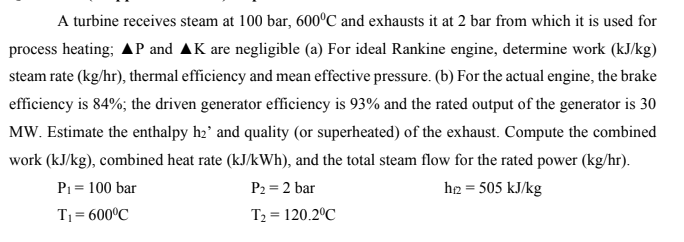A turbine receives steam at 100 bar, 600°C and exhausts it at 2 bar from which it is used for process heating; AP and AK are negligible (a) For ideal Rankine engine, determine work (kJ/kg) steam rate (kg/hr), thermal efficiency and mean effective pressure. (b) For the actual engine, the brake efficiency is 84%; the driven generator efficiency is 93% and the rated output of the generator is 30 MW. Estimate the enthalpy h₂' and quality (or superheated) of the exhaust. Compute the combined work (kJ/kg), combined heat rate (kJ/kWh), and the total steam flow for the rated power (kg/hr). h2 = 505 kJ/kg P₂= 2 bar P₁ = 100 bar T₁ = 600°C T₂ = 120.2°C
A turbine receives steam at 100 bar, 600°C and exhausts it at 2 bar from which it is used for process heating; AP and AK are negligible (a) For ideal Rankine engine, determine work (kJ/kg) steam rate (kg/hr), thermal efficiency and mean effective pressure. (b) For the actual engine, the brake efficiency is 84%; the driven generator efficiency is 93% and the rated output of the generator is 30 MW. Estimate the enthalpy h₂' and quality (or superheated) of the exhaust. Compute the combined work (kJ/kg), combined heat rate (kJ/kWh), and the total steam flow for the rated power (kg/hr). h2 = 505 kJ/kg P₂= 2 bar P₁ = 100 bar T₁ = 600°C T₂ = 120.2°C
Elements Of Electromagnetics
7th Edition
ISBN:9780190698614
Author:Sadiku, Matthew N. O.
Publisher:Sadiku, Matthew N. O.
ChapterMA: Math Assessment
Section: Chapter Questions
Problem 1.1MA
Related questions
Question
Answer a) only

Transcribed Image Text:A turbine receives steam at 100 bar, 600°C and exhausts it at 2 bar from which it is used for
process heating; AP and AK are negligible (a) For ideal Rankine engine, determine work (kJ/kg)
steam rate (kg/hr), thermal efficiency and mean effective pressure. (b) For the actual engine, the brake
efficiency is 84%; the driven generator efficiency is 93% and the rated output of the generator is 30
MW. Estimate the enthalpy h₂' and quality (or superheated) of the exhaust. Compute the combined
work (kJ/kg), combined heat rate (kJ/kWh), and the total steam flow for the rated power (kg/hr).
P₂ = 2 bar
h+2 = 505 kJ/kg
P₁ = 100 bar
T₁ = 600°C
T₂ = 120.2°C
Expert Solution
This question has been solved!
Explore an expertly crafted, step-by-step solution for a thorough understanding of key concepts.
This is a popular solution!
Trending now
This is a popular solution!
Step by step
Solved in 6 steps with 6 images

Knowledge Booster
Learn more about
Need a deep-dive on the concept behind this application? Look no further. Learn more about this topic, mechanical-engineering and related others by exploring similar questions and additional content below.Recommended textbooks for you

Elements Of Electromagnetics
Mechanical Engineering
ISBN:
9780190698614
Author:
Sadiku, Matthew N. O.
Publisher:
Oxford University Press

Mechanics of Materials (10th Edition)
Mechanical Engineering
ISBN:
9780134319650
Author:
Russell C. Hibbeler
Publisher:
PEARSON

Thermodynamics: An Engineering Approach
Mechanical Engineering
ISBN:
9781259822674
Author:
Yunus A. Cengel Dr., Michael A. Boles
Publisher:
McGraw-Hill Education

Elements Of Electromagnetics
Mechanical Engineering
ISBN:
9780190698614
Author:
Sadiku, Matthew N. O.
Publisher:
Oxford University Press

Mechanics of Materials (10th Edition)
Mechanical Engineering
ISBN:
9780134319650
Author:
Russell C. Hibbeler
Publisher:
PEARSON

Thermodynamics: An Engineering Approach
Mechanical Engineering
ISBN:
9781259822674
Author:
Yunus A. Cengel Dr., Michael A. Boles
Publisher:
McGraw-Hill Education

Control Systems Engineering
Mechanical Engineering
ISBN:
9781118170519
Author:
Norman S. Nise
Publisher:
WILEY

Mechanics of Materials (MindTap Course List)
Mechanical Engineering
ISBN:
9781337093347
Author:
Barry J. Goodno, James M. Gere
Publisher:
Cengage Learning

Engineering Mechanics: Statics
Mechanical Engineering
ISBN:
9781118807330
Author:
James L. Meriam, L. G. Kraige, J. N. Bolton
Publisher:
WILEY